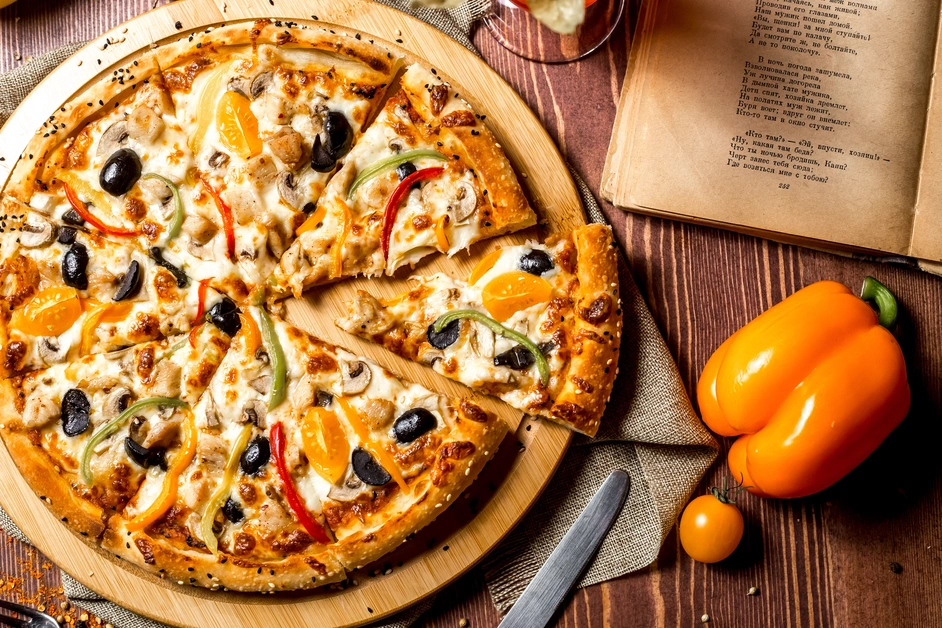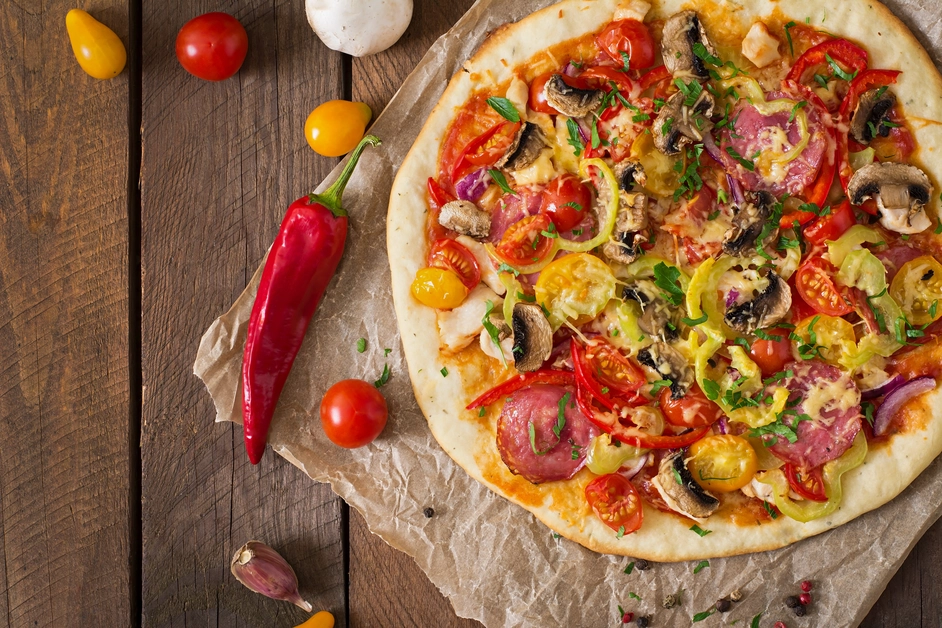Few dishes can match the satisfying experience of biting into a freshly baked supreme pizza. Loaded with bold flavors, this pizza type brings together a balanced medley of meats, vegetables, sauce, and gooey cheese. It’s a go-to favorite for anyone who loves variety and richness in every bite.
Supreme pizza isn’t just a meal—it’s a celebration of classic toppings layered to perfection. With a base of savory tomato sauce and melty mozzarella, it’s topped with fan favorites like pepperoni, sausage, onions, bell peppers, mushrooms, and olives. The combination delivers taste and texture in every slice.
This ultimate guide explores what sets supreme pizza apart. You’ll learn about its ingredients, how to make it at home, how it compares to other popular types, and the best ways to store leftovers safely. Additionally, we’ll look at nutritional details, regional variations, and smart pairing ideas.
Whether you’re a pizza pro or just discovering your favorite style, this article will help you master the art of enjoying supreme pizza to the fullest. Stick around—you might even pick up a new topping combo or recipe tip along the way. Let’s dive into the flavorful world of supreme pizza.
What Is a Supreme Pizza?
A supreme pizza is a delicious and indulgent dish that stands out for its generous assortment of toppings, carefully chosen to create a well-balanced and flavorful combination. This pizza variety often features a rich mix of savory meats, such as pepperoni, sausage, and sometimes ground beef or ham, providing a satisfying, protein-packed foundation. To complement the meats, a colorful array of vegetables like onions, bell peppers, mushrooms, and black olives is added, offering freshness, crunch, and a touch of sweetness.
The appeal of this pizza lies in its ability to cater to a wide range of tastes, making it a popular choice for groups or anyone who enjoys layers of flavor in a single bite. Each ingredient contributes to a dynamic texture and taste, blending together in harmony atop a golden, crispy crust and melted cheese. While variations in the recipe can be found across different regions and pizzerias, the essence of a supreme pizza remains the same: a celebration of variety and indulgence.
Perfect for those who appreciate a more loaded, substantial meal, this pizza delivers a rich and satisfying experience that goes beyond the basics of traditional toppings. It’s a bold choice for bold appetites.

Ingredients That Define It
Although ingredients can vary slightly by region or restaurant, most supreme pizzas share a core set of toppings.
Common Ingredients
- Crust: Traditional hand-tossed or pan crust
- Sauce: Tomato-based pizza sauce
- Cheese: Mozzarella (sometimes with provolone)
- Meats:
- Pepperoni
- Italian sausage
- Ground beef or bacon (optional)
- Vegetables:
- Green bell peppers
- Red onions
- Mushrooms
- Black olives
Optional Add-Ons
- Banana peppers for tang
- Jalapeños for heat
- Extra cheese for indulgence
These ingredients work together to deliver the layered flavor that defines supreme pizza.
How to Make Supreme Pizza at Home
Making your own supreme pizza is easier than you might think. Here’s how to do it right.
Ingredients You’ll Need
- 1 ball pizza dough (store-bought or homemade)
- 1 cup pizza sauce
- 2 cups shredded mozzarella
- 15 slices pepperoni
- 1/2 cup cooked Italian sausage
- 1/4 cup sliced mushrooms
- 1/4 cup sliced green bell peppers
- 1/4 cup sliced onions
- 1/4 cup sliced black olives
Step-by-Step Instructions
- Preheat oven to 475°F.
- Roll out dough on a floured surface.
- Spread sauce evenly over the dough.
- Add cheese, distributing it all over.
- Layer meats and vegetables on top.
- Bake for 12–15 minutes or until crust is golden and cheese is bubbly.
Let the pizza cool for a few minutes before slicing. Enjoy!

Nutritional Breakdown
While a supreme pizza is undeniably a flavorful and satisfying meal, it’s important to consider its nutritional content, especially for those who are mindful of their diet. A typical slice—about one-eighth of a standard 14-inch pizza—contains approximately 280 to 350 calories. This can vary depending on the specific ingredients used, but it gives a general idea of what to expect from a single serving.
In terms of macronutrients, each slice usually includes 12 to 18 grams of fat, 30 to 35 grams of carbohydrates, and 12 to 15 grams of protein. These numbers reflect the hearty mix of meats, cheese, and crust that contribute to both its taste and its calorie count. Sodium levels can also be relatively high, ranging from 600 to 800 milligrams per slice, primarily due to the processed meats and cheeses often used.
Of course, the exact values can shift depending on the brand or preparation method. Store-bought and restaurant versions may contain more preservatives and fats, while homemade options offer the opportunity to use leaner meats, less cheese, and whole-grain crusts for a more health-conscious twist. Understanding this profile helps pizza lovers enjoy it in moderation and make informed choices.
Popular Variations
One of the best things about supreme pizza is its flexibility—there’s no strict recipe to follow, which opens the door to endless customization. This versatility allows people from all regions and dietary backgrounds to enjoy their own unique version of this classic favorite.
Different areas have put their own spin on the supreme pizza, creating regional variations that reflect local tastes. For example, the Chicago-style supreme features a deep-dish crust with layers of hearty toppings and a rich, chunky tomato sauce, delivering a filling, fork-and-knife experience. In contrast, the New York supreme is built on a thin, crisp crust, ideal for folding and eating on the go. Then there’s the Tex-Mex supreme, which blends spicy flair with ingredients like jalapeños, cheddar cheese, and seasoned taco meat—bringing a zesty twist to the traditional formula.
Supreme pizza also adapts well to dietary preferences. Keto-friendly versions use cauliflower crust and low-carb sauces to keep the flavor while cutting carbs. Vegan supreme pizzas swap in plant-based meats and dairy-free cheese, making it possible to enjoy all the richness without any animal products.
These creative versions prove that supreme pizza can evolve to suit just about anyone, offering bold flavor and satisfying variety in every slice.

Best Sides and Pairings
Supreme pizza, with its bold and hearty flavors, pairs exceptionally well with a variety of sides and beverages that can elevate the overall dining experience. Choosing the right accompaniments can enhance the richness of the pizza and provide a satisfying balance to its savory toppings.
Popular side dishes include garlic knots, which add a warm, buttery touch that complements the pizza’s texture. A Caesar salad offers a refreshing crunch and a tangy contrast to the rich meats and cheeses. For those craving extra indulgence, mozzarella sticks bring a gooey, cheesy element to the table. An antipasto platter, featuring cured meats, olives, and marinated vegetables, adds a sophisticated flair and mirrors the variety found in the pizza itself.
When it comes to drinks, classic soda choices like cola or root beer provide a fizzy, sweet counterbalance to the savory notes. For an adult twist, a light lager can cleanse the palate, while a glass of red wine—such as Chianti—pairs beautifully with the pizza’s complex flavors.
These pairings aren’t just about taste—they’re about creating a complete, enjoyable meal that satisfies every craving. Whether casual or elevated, the right combinations bring out the best in a supreme pizza experience.
Supreme Pizza vs. Other Types
What truly sets a supreme pizza apart is its balance of flavors and textures, offering a well-rounded experience that appeals to a wide range of palates. When compared to other popular types of pizza, its unique combination of ingredients becomes even more apparent.
Take pepperoni pizza, for instance. It’s a classic favorite known for its simplicity and bold, spicy flavor. With just one main topping, pepperoni pizza is straightforward and satisfying, but it lacks the complexity found in a supreme. A supreme pizza, on the other hand, delivers layers of flavor by combining multiple meats with a colorful mix of vegetables. The result is a more diverse and dynamic bite every time.
Now consider veggie pizza. While it’s a great option for those avoiding meat, it doesn’t offer the same savory depth. Supreme pizza includes vegetables like onions and bell peppers, but also features hearty meats like sausage and pepperoni. This combination brings together the freshness of veggies and the richness of protein in a way that veggie pizza alone does not.
When compared to a meat lover’s pizza, which focuses heavily on a variety of meats, supreme pizza again strikes a middle ground. Meat lover’s can be indulgent but sometimes overwhelming. Supreme pizza offers balance—flavorful meats are offset by the lighter, crisp textures of vegetables.
In essence, supreme pizza stands out as a harmonious blend of all the elements people love about pizza: it’s savory, colorful, hearty, and satisfying. It appeals to those who want variety without sacrificing flavor or texture. Whether you’re sharing with a group or indulging solo, it offers a little bit of everything, making it one of the most versatile and well-loved options on any menu.
Storage and Food Safety
Proper storage is essential to keep your supreme pizza fresh, safe, and delicious for later enjoyment. Whether you’re saving leftovers from dinner or meal-prepping for the week, understanding how to store your pizza correctly helps maintain both taste and safety.
For short-term storage, leaving pizza at room temperature is only safe for up to two hours. After that, bacteria can begin to grow, increasing the risk of foodborne illness. If you plan to eat it later, refrigeration is your best bet. When properly stored in an airtight container or wrapped tightly, supreme pizza can last up to four days in the fridge while still retaining decent flavor and texture.
For longer storage, freezing is a great option. To preserve the best taste and quality, it’s ideal to eat frozen pizza within one to two months. Be sure to wrap slices individually in foil or plastic wrap, then place them in a freezer-safe bag to avoid freezer burn.
When it’s time to reheat, skip the microwave if possible. Using an oven or air fryer helps restore the crispy crust and melty toppings, giving you a result closer to fresh-baked. Most importantly, never leave pizza out overnight, as this significantly raises health risks.
Conclusion
supreme pizza stands as a versatile and beloved choice for pizza enthusiasts worldwide. Its unique combination of savory meats, fresh vegetables, and melted cheese offers a rich, balanced flavor that appeals to a wide range of tastes. Whether enjoyed in its classic form or customized with regional twists and dietary variations, supreme pizza can cater to virtually any preference. From the deep-dish Chicago-style to the spicy Tex-Mex version, and even keto and vegan alternatives, there is a supreme pizza for everyone. The fun of creating and savoring different versions ensures that no two experiences are exactly alike.
Frequently Asked Questions (FAQs)
How long can a supreme pizza sit out?
Supreme pizza should not sit out longer than 2 hours. Bacteria can grow quickly at room temperature.
What is typically on a supreme pizza?
Typically, it includes pepperoni, sausage, mushrooms, onions, bell peppers, and olives, all on a cheesy, saucy crust.
Why is it called a supreme pizza?
The term “supreme” refers to the abundance of toppings. It combines several favorites into one “supreme” experience.
How long is supreme pizza good for?
In the fridge, it lasts about 3–4 days. In the freezer, up to 2 months. Always store it in an airtight container.
How fast can pizza go bad?
Pizza goes bad within 2 hours at room temperature. In warm environments, it may spoil even faster.
How long do pizza kits last?
Most pizza kits last 1–2 weeks in the fridge. Always check the expiration date and store it properly.
For more recipes, please clik on link below :

